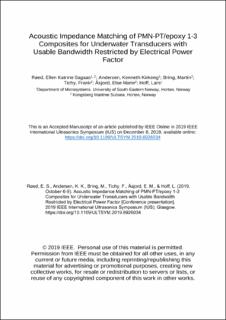| dc.contributor.author | Røed, Ellen Katrine Sagaas | |
| dc.contributor.author | Andersen, Kenneth Kirkeng | |
| dc.contributor.author | Bring, Martin | |
| dc.contributor.author | Tichy, Frank | |
| dc.contributor.author | Åsjord, Else-Marie | |
| dc.contributor.author | Hoff, Lars | |
| dc.date.accessioned | 2022-08-04T13:17:51Z | |
| dc.date.available | 2022-08-04T13:17:51Z | |
| dc.date.created | 2019-11-12T11:44:47Z | |
| dc.date.issued | 2019 | |
| dc.identifier.citation | Røed, E. S., Andersen, K. K., Bring, M., Tichy, F., Åsjord, E. M., & Hoff, L. (2019, October 6-9). Acoustic Impedance Matching of PMN-PT/epoxy 1-3 Composites for Underwater Transducers with Usable Bandwidth Restricted by Electrical Power Factor [Conference presentation]. 2019 IEEE International Ultrasonics Symposium (IUS). Glasgow. | en_US |
| dc.identifier.issn | 1948-5719 | |
| dc.identifier.uri | https://hdl.handle.net/11250/3010182 | |
| dc.description.abstract | Volume cost has limited the use of single crystals in underwater applications, butreported performance of PMN-PT sonar transducers now motivates the design of commercial prototypes. This work addresses optimization of the matching layer for maximum bandwidth of underwater transducers made fromPMN-PT/epoxy 1-3 composite plates. Bandwidth is here defined by both the electromechanicaltransfer function and the electrical power factor. The electrical power factor is theratio of real to apparent power andmust be taken into account forsystems with transmitter volt-amperelimitations. PMN-PT single crystals has a higher electromechanical coupling coefficient than commonly used PZT. This requires a lower mechanical quality factor of the transducer design to avoid increased fluctuation of the tuned power factor. For a PMN-PT/epoxy composite with air backing and one matching layer it is challenging to achieve optimum mechanical quality factor, resulting in possible power factor limitation of bandwidth. | en_US |
| dc.language.iso | eng | en_US |
| dc.title | Acoustic Impedance Matching of PMN-PT/epoxy 1-3 Composites for Underwater Transducers with Usable Bandwidth Restricted by Electrical Power Factor | en_US |
| dc.type | Peer reviewed | en_US |
| dc.type | Journal article | en_US |
| dc.description.version | acceptedVersion | en_US |
| dc.rights.holder | © 2019 IEEE. | en_US |
| dc.source.pagenumber | 1781-1784 | en_US |
| dc.source.journal | Proceedings - IEEE Ultrasonics Symposium | en_US |
| dc.identifier.doi | https://doi.org/10.1109/ULTSYM.2019.8926034 | |
| dc.identifier.cristin | 1746436 | |
| dc.relation.project | Norges forskningsråd: 290462 | en_US |
| dc.relation.project | Norges forskningsråd: 237887 | en_US |
| dc.relation.project | Norges forskningsråd: 245963 | en_US |
| cristin.ispublished | true | |
| cristin.fulltext | postprint | |
| cristin.fulltext | postprint | |
| cristin.qualitycode | 1 | |
